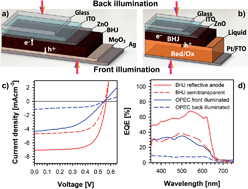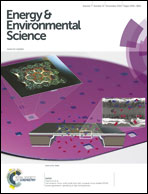Organic photoelectrochemical cells with quantitative photocarrier conversion†
Abstract
Efficient solar-to-fuel conversion could be a cost-effective way to power the planet using sunlight. Herein, we demonstrate that Organic Photoelectrochemical Cells (OPECs) constitute a versatile platform for the efficient production of solar fuels. We show that the photogenerated carriers at the organic active layer can be quantitatively extracted to drive photoelectrochemical reactions at the interface with a liquid solution. Indeed, an unprecedented photocurrent of 4 mA cm−2 is extracted for an OPEC device, comparable to that of a solid-state device with similar optical properties. Through the careful choice of the selective contact and the redox couple in the liquid medium, we can tune the energetics of the system and activate either oxidative or reductive chemistry. The design rules to drive the desired electrochemical reaction are provided based on a comprehensive study of the energetic aspects of OPEC configuration. Finally, we demonstrate that OPEC devices effectively produce hydrogen in acetonitrile when a cobaloxime based homogeneous catalyst is present in the solution, and HCl is used a source of protons.


 Please wait while we load your content...
Please wait while we load your content...